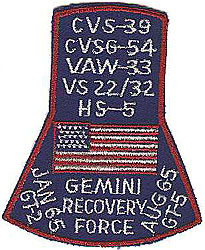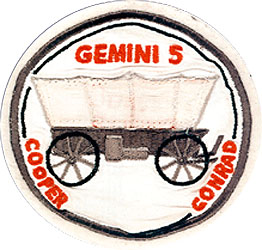

Crew & Mission
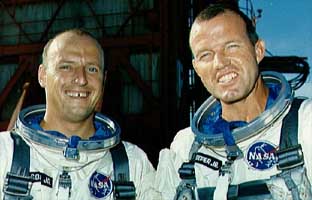 The Crews for the Gemini-V mission was selected on February 8, 1965. Astronauts L. Gordon Cooper Jr. and Charles Conrad Jr. would be the prime crew, and astronauts Neil Armstrong and Elliot See would be back-up.
The Crews for the Gemini-V mission was selected on February 8, 1965. Astronauts L. Gordon Cooper Jr. and Charles Conrad Jr. would be the prime crew, and astronauts Neil Armstrong and Elliot See would be back-up.
Gemini-V was launched from Cape kennedy at 9:00 am EST, August 21, 1965. The early phases of the flight went according to plan but a rapid drop in pressure in the cryogenic storage thanks which supplied the fuel cells required that many of the planned activities be curtailed or abandoned.
Flight Director Chistopher C. Kraft, Jr., decided to have Gemini-V perform a rendezvous with a "phantom Agena" target during the third day of the mission. Astronauts Cooper and Conrad were instructed to perform four maneuvers during a period of two revolutions. These maneuvers were accomplished and ground tracking indicated that the simulated rendezvous maneuver would have placed the spacecraft within three-tenths of a mile of the target.
During the flight Gemini-V attained a maximum apogee of 188.9 miles. Following retrofire the Gemini-V spacecraft touched down in the western Atlantic approximately 90 miles short of the predicted impact point. The touchdown time was 7:55:14 am EST, August 29, following a flight wich had lasted 190 hours, 55 minutes and 14 seconds. The crew was recovered at 9:26 am and the Gemini-V spacecraft was picked up by the prime recovery ship, the USS Lake Champlain, at 11:50 am.
A Personal Story
..."Beginning with Gemini, NASA administrator Jim Webb decided he didn't want U.S. spacecraft to have names. Now we all liked Webb and admired his abilities, but we did find ourselves arguing with him a lot. His decision to "depersonalize" the space program was our biggest argument ever. He wanted the flights referred to by numbers, "I want the flights all very machine oriented", Webb explained. It was serious miscalculation on his part because the personalized stuff - not the science or electronic advances - was what the public identified with and enjoyed the most.
We kept trying to get Webb to change his mind. Pete came up with the notion of naming our spacecraft Lady Bird in honor of President Johnson's wife. We figured there was a good chance it would be approved, given that we wanted to name it after the First Lady. But NASA turned us down.
Several months before the mission, I mentioned to Pete that I'd never been in a militairy organization that didn't have its own patch. Pete hadn't either. We decided right then and there that we were at least going to have a patch for our flight. Pete's father-in-law had whittled a model of a Conestoga wagon, the preferred mode of transportation for pioneers of an earlier era. We thought a covered wagon might be a good way to symbolize the pioneering nature of our flight. Since our mission was designed to last eight days, the longest ever attempted by the United States or the Soviet Union, we came up with the slogan "8 Days or Bust", which we overlaid on a Conestoga wagon. We gave the design to a local patch company, and they produced hundreds of them. Pete and I had ours sewn on the right breast of our space suits.
Two days before launch, Jim Webb, in from Washington, beckoned us to Houston for what was to become a prelaunch tradition: dinner and a social evening for the prime crew. That night during dinner, I decided we had to tell Webb about our "8 Days or Bust" patch because it wasn't fair for him to find out by surprise or through the media.
"Jim, you've taken away our spacecraft names away from us, and as you know, none of us particularly liked it", I said. "Pete and I want to personalize our flight, and we've designed a realy neat mission patch". Webb about went into hysterics. The patch was in direct violation of his efforts to depersonalize the space program. The argument got so heated that at one point Bob Gilruth and I had to pull Webb and Pete apart - the overall head of NASA and one of his astronauts were stopped just short of fistcuffs. When Webb cooled down, I explained how Pete and I had never been in any military organization that didn't have a patch. "It's not just for the guys flying", I went on, "But for the hundreds of people working on the launch equipment and operating the worldwide tracking range and all the other things that go into a succesful mission. Wearing that patch tells the world that they worked Gemini-5".
Webb asked me if I had the patch with me. Unfortunately, we hadn't thought to bring one. He asked that one be flown to Washington the next day. "I'll look at it and make a decision", he said. "Fair enough, Jim". The next day, after reviewing the patch, Webb called me at the Cape; "All right, I'll approve this patch on one condition". "What's that?". "That you cover up the '8 Days or Bust' until you make the eight days. If you don't make eight days, I don't want the press having a field day about the mission being a bust". So we had little pieces of canvas lightly sewn over the offending slogan. In his official memo authorizing the patch, Webb directed that all future space crews could have their own mission patch, henceforth to be 'referred to by generic name of the Cooper patch' - a tradition that still lives today"...
From: Leap of Faith, By astronaut Gordon Cooper.
..."Conrad wanted to name our Gemini spacecraft "Lady Bird" in honor of President Johnson's wife, but that was turned down. NASA was still not ready to let us name our spacecraft. Finaly, Pete and I tackled them with the idea of a crew patch. Pete's father-in-law had whittled a model of a Convered Wagon and I thought that was a good way to symbolize the pioneering nature of these early flights. The 8 days or bust wording just sort of followed along naturally. Pete and I had dinner with Mr. Webb and brought up the subject to him. We told him that NASA had taken our names away from us and we didn't particularly like it. We wanted to personalize our flight. And you know what, we won"...
Astronaut Gordon Cooper in; "All we did was fly to the moon".
..."Gordo and Pete were still trying to find a way to individualize their spacecraft. Gus and John had managed to name GT-3; Jim and Ed had worn the American flag on GT-4. Pete hit on the idea of a patch, the kind of thing every Navy air squadron has. It showed a Conestoga wagon with the slogan, "Eight Days or Bust". When Jim Webb saw that, however, he had a fit. He didn't want the motto, for one thing, and decided upon a whole set of guidelines for what he called "Cooper patches" that each crew commander could design and wear.".....
From, "DEKE ! - U.S. Manned space: from Mercury to the Shuttle" by astronaut Deke Slayton.
Webb's memo
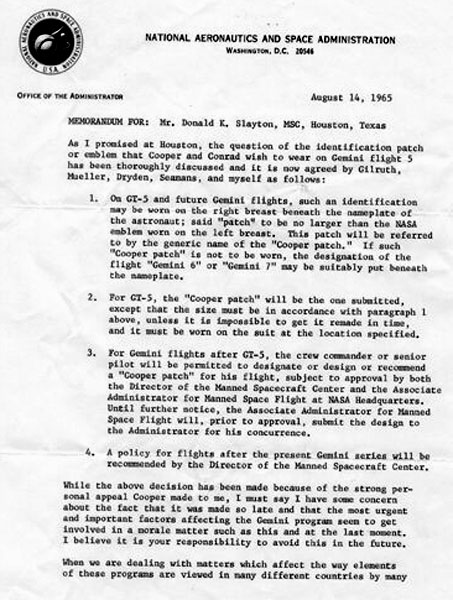
The memo continues:
"...different nationalities, we cannot leave to the crew the decision with respect to these matters no matter how strongly they feel that would like to have some element of individuality. In this case, both Dr. Gilruth and I have a very strong concern about the "8 days or bust" motto. I wish it could be omitted. If the flight does not go 8 days, there are many who are going to
say that it was "busted". Further, whether we get the 8 days or not, the way the language will be translated in certain countries will not be benefit of the the United States."
The Real Thing
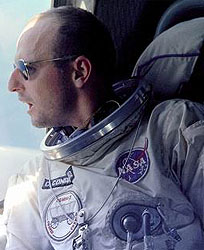
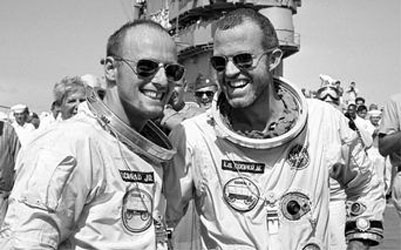
Left: Conrad in the helicopter following splash-down. Right: Conrad and Gordon aboard the recovery ship.
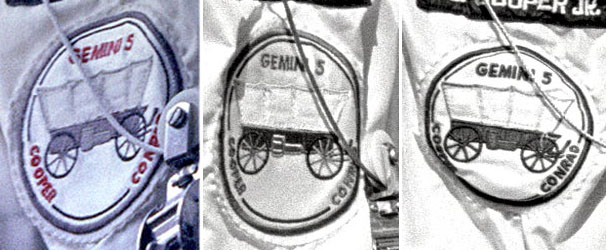
Comparison of the patches. The pictures were taken from Gene Dorr's site. Contrary to Dorr, we believe the patch shown in NASA photograph S66-59530, shown at the top of the page, is Cooper's patch, since the shape of the black line that forms the upper half of the circle is identical. The "elongated R" might simply be a lose red thread.
The Artwork
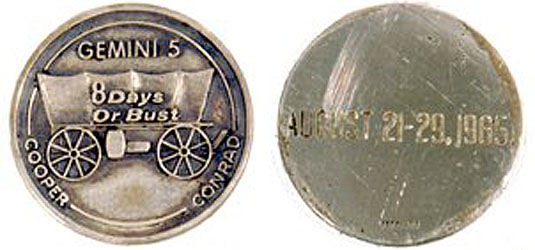
A flown sterling silver medallion, showing the motto "8 Days or Bust". Since it was flown, the medallion must have been produced around the same time as the original embroidered patch, using the original artwork. It shows what the "8Days Or Bust" motto looked like.
Variation
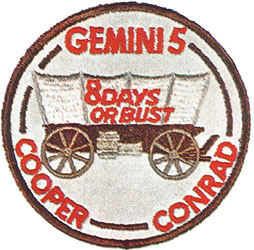
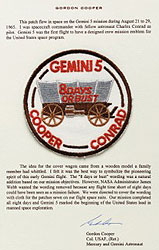
According to the document signed by Gordon Cooper for an auction, this is one of a batch of souvenir patches that were flown aboard the spacecraft. It is smaller than the patch that was sewn on the spacesuits, which is probably te reason why the lettering differs drom the original artwork. To keep it readable, the Gemini-5 legend was enlarged, making it necessary to place it in the outer ring. The "8 Days or Bust" motto is embroidered in capitals, probably for the same reason.
If this patch was indeed flown, a question comes to mind: if a smaller patch was available at the time of the flight, why didn't the astronauts wear it on their suits - like Webb had explicitly ordered in his memo? An explanation - if the patch was indeed flown - might be that this is the smaller patch that Webb had ordered, but that it was delivered to the crew too late to have it sewn to the space suits.
Another explanation is that this is a souvenir version produced after the flight, of which Cooper - some thirty years later - mistakenly assumed it was flown. Evidence to support this, is the fact that Cooper's and Conrad's patches seem to have been hand-embroidered, while the "flown" patch clearly is machine-embroidered.
Souvenir
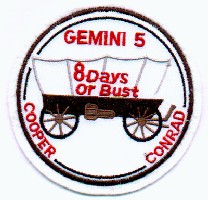
Recovery Force
